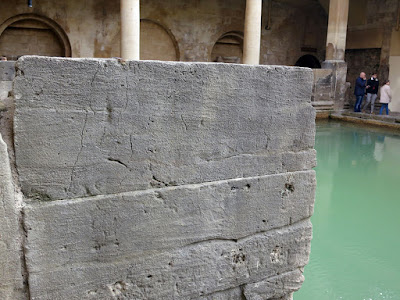Keyword: Traditional architectures, Geology in life
I visited many towns in UK to observe outcrops, coasts and rivers. In every towns, I found cathedrals and castles build in middle ages. Most of them have a highest towers in the areas and I can climb them. The view from the towers is very useful to glasp geological and geographical background of the area. So (not only for siteseeing), I visited them during my field surveys.
At first, I surprised the beautiful Gothic or Norman style structures made of stones, stained glass and their histories. But next, I began to be interested in the lithology of them. As I visited many areas, I noticed that the lithology of such a old buildings seems to be different depending on areas. It represents the relationships between geology and human activities. Most of the buildings are made of the stones in the area but some
ones are made of others. There will be fascinating stories about the history of logistics, culture and politics. Most of Japanese old buildings are made of woods so It is difficult to enjoy and discuss about these topics in Japan.
I am just a geologist (Sedimentologist) in Japan not a specialist in traditional architectures or history in UK. But I would like to introduce the lithology of cathedrals and castles in many areas.
We can easily get the lithological information in each areas from website "Geology of Britain viewer" by British Geological Survey. Please compare and enjoy the lithology of the buildings and geology in the area.
Hartlepool (County Durham), sandy tidal flat deposit
 |
| Flaser forks (mud drapes in trough of ripple) which indicate repetition of water current and stop (tide) |
 |
| Double mud drapes which indicate diurnal inequality of tide. |
 |
| Herring bone structures which indicate bidirectional flows (tidal currents). |
York (North Yorkshire), shallow marine deposit
 |
| City wall made of sand stones with cross laminae. |
 |
| Sand stone with trough cross laminae and borrows. |
Frambrough (East Riding of Yorkshire), chalk
 |
| Lighthouse made of chalk. |
Cromer (Norfolk), flint
 |
| Cromer Parish Church made of flint. |
 |
| Close-up of the church. |
Wells (Norfolk), gravel
 |
| Wall made of gravels. |
 |
| Close-up. Flint ? |
Norwich (Norfolk), flint
 |
| Tower made of flint. |
 |
| Close-up of the tower. |
 |
| City wall. |
 |
| City wall made of flint. |
 |
| Close-up of the wall. Holes by boring shells. |
 |
| Close-up of the wall. Limestone (bryozoan sand ?). |
Dover (Kent), flint
 |
| City wall made of flint. |
 |
| St. Marys Church in Dover made of flint. |
 |
| Close-up of wall made of filnt. |
Portchester (Hampshire)
 |
| Portchester Castle near tidal flat and chalk bed with white color. |
 |
| Outer wall of Portchester Castle. It is originally made of flint and repaired by other stones. |
 |
| Inside of the castle. It has been repaired many times and by various stones, including bricks. |
 |
| Close-up of inside wall of the castle. |
Nottingham (Notthinghamshire)
 |
| Outer wall of Nottingham Castle. The lower is natural sand stone. |
 |
| Close-up of the wall with cross bed. |
 |
| Close-up of the wall. |
 |
Sand stone in the castle. The half of the pub, oldest in England, is in the sand stone.
We can enjoy ale and attractive sedimentary structures at the same time ! |
Bath (Somerset)
 |
Sand stone with trough cross laminae in thermae (public bath in Roman style).
It was constructed during ancient Roman periods and repaired during the Middle Age. |
Bristol (South West England)
 |
| Wall made of schist ? |
Cardiff (Wales)
 |
| Outer wall of Cardiff Castle. It was repaired many times. |
 |
| Close-up of the wall. Sand stone with many shells. |
 |
| Close-up of the wall. Poor sorted sand-gravel stone. |
 |
| Close-up of the wall. Sand stone with many shells. |
 |
| Close-up of the wall. Gravel. |
Cotswolds (Gloucestershire), honey-colored limestone
 |
| Beautiful buildings with honey color. |
 |
| Beautiful buildings made of limestone and flint. |
 |
| Fence made of limestone. |
 |
| Close-up of honey-colored stones. |
 |
| Close-up of buildings made of flint and limestones. |
Windermere (Lake District, Cumbria), schist
 |
| Windermere with buildings made of schist (?). |
 |
| Fence made of schist (?). |
 |
| Church made of schist (?). |
 |
| Close-up of buildings made of schist (?). |










































